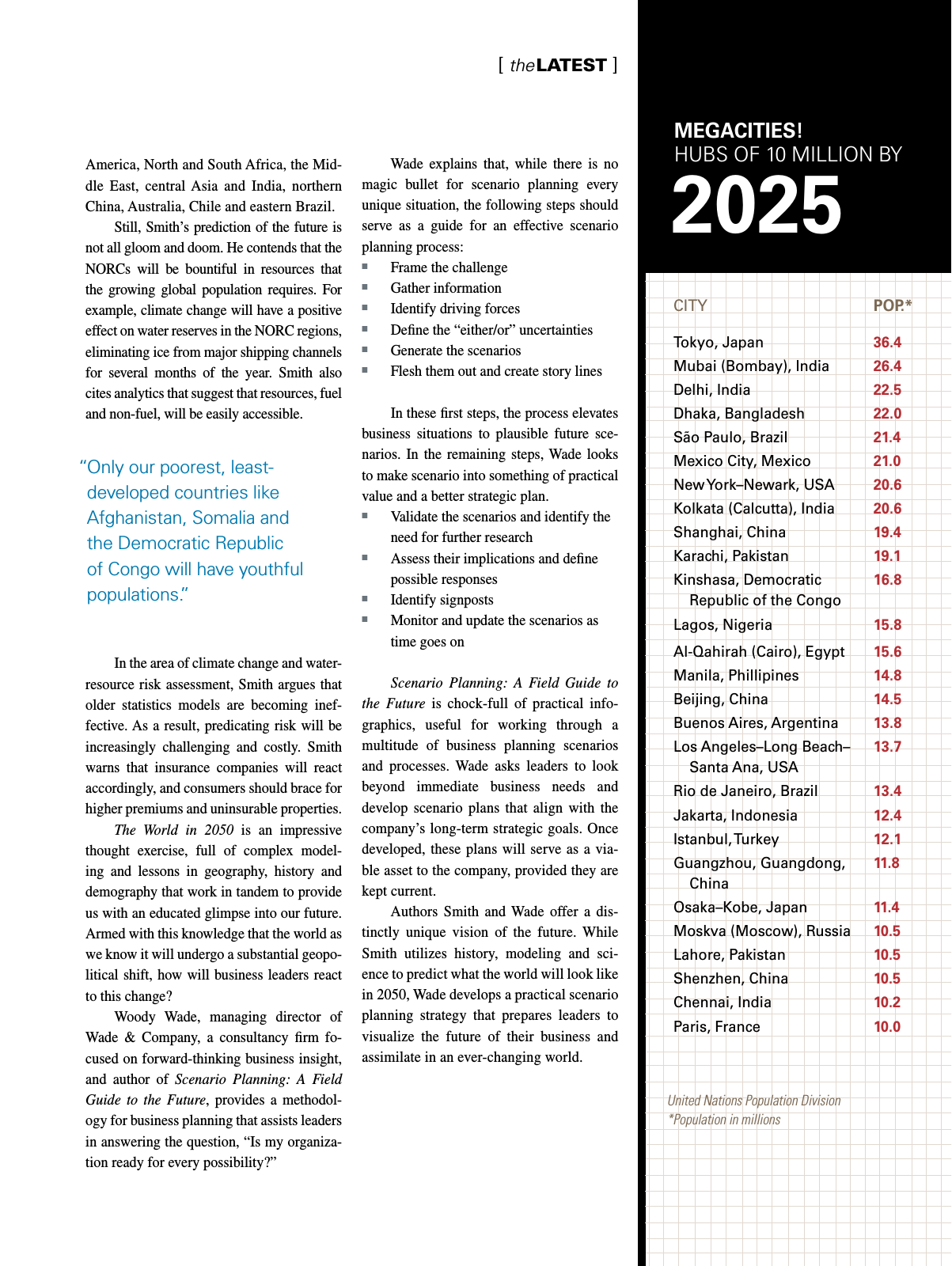Reason Mag Q1 2014 Seite 15
Hinweis: Dies ist eine maschinenlesbare No-Flash Ansicht.Klicken Sie hier um zur Online-Version zu gelangen.
Inhalt
ISSUE 1 2014 Reason 15 theLATEST America North and South Africa the Mid dle East central Asia and India northern China Australia Chile and eastern Brazil Still Smith s prediction of the future is not all gloom and doom He contends that the NORCs will be bountiful in resources that the growing global population requires For example climate change will have a positive effect on water reserves in the NORC regions eliminating ice from major shipping channels for several months of the year Smith also cites analytics that suggest that resources fuel and non fuel will be easily accessible In the area of climate change and water resource risk assessment Smith argues that older statistics models are becoming inef fective As a result predicating risk will be increasingly challenging and costly Smith warns that insurance companies will react accordingly and consumers should brace for higher premiums and uninsurable properties The World in 2050 is an impressive thought exercise full of complex model ing and lessons in geography history and demography that work in tandem to provide us with an educated glimpse into our future Armed with this knowledge that the world as we know it will undergo a substantial geopo litical shift how will business leaders react to this change Woody Wade managing director of Wade Company a consultancy rm fo cused on forward thinking business insight and author of Scenario Planning A Field Guide to the Future provides a methodol ogy for business planning that assists leaders in answering the question Is my organiza tion ready for every possibility Wade explains that while there is no magic bullet for scenario planning every unique situation the following steps should serve as a guide for an effective scenario planning process Q Frame the challenge Q Gather information Q Identify driving forces Q De ne the either or uncertainties Q Generate the scenarios Q Flesh them out and create story lines In these rst steps the process elevates business situations to plausible future sce narios In the remaining steps Wade looks to make scenario into something of practical value and a better strategic plan Q Validate the scenarios and identify the need for further research Q Assess their implications and de ne possible responses Q Identify signposts Q Monitor and update the scenarios as time goes on Scenario Planning A Field Guide to the Future is chock full of practical info graphics useful for working through a multitude of business planning scenarios and processes Wade asks leaders to look beyond immediate business needs and develop scenario plans that align with the company s long term strategic goals Once developed these plans will serve as a via ble asset to the company provided they are kept current Authors Smith and Wade offer a dis tinctly unique vision of the future While Smith utilizes history modeling and sci ence to predict what the world will look like in 2050 Wade develops a practical scenario planning strategy that prepares leaders to visualize the future of their business and assimilate in an ever changing world MEGACITIES HUBS OF 10 MILLION BY 2025 theLATEST Only our poorest least developed countries like Afghanistan Somalia and the Democratic Republic of Congo will have youthful populations CITY POP Tokyo Japan 36 4 Mubai Bombay India 26 4 Delhi India 22 5 Dhaka Bangladesh 22 0 São Paulo Brazil 21 4 Mexico City Mexico 21 0 New York Newark USA 20 6 Kolkata Calcutta India 20 6 Shanghai China 19 4 Karachi Pakistan 19 1 Kinshasa Democratic Republic of the Congo 16 8 Lagos Nigeria 15 8 Al Qahirah Cairo Egypt 15 6 Manila Phillipines 14 8 Beijing China 14 5 Buenos Aires Argentina 13 8 Los Angeles Long Beach Santa Ana USA 13 7 Rio de Janeiro Brazil 13 4 Jakarta Indonesia 12 4 Istanbul Turkey 12 1 Guangzhou Guangdong China 11 8 Osaka Kobe Japan 11 4 Moskva Moscow Russia 10 5 Lahore Pakistan 10 5 Shenzhen China 10 5 Chennai India 10 2 Paris France 10 0 United Nations Population Division Population in millions
